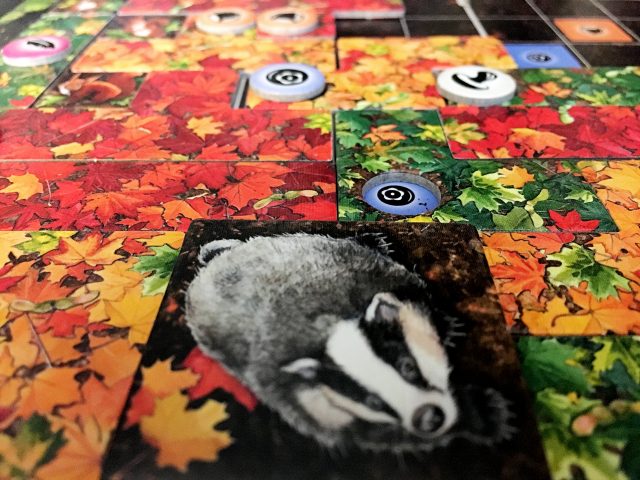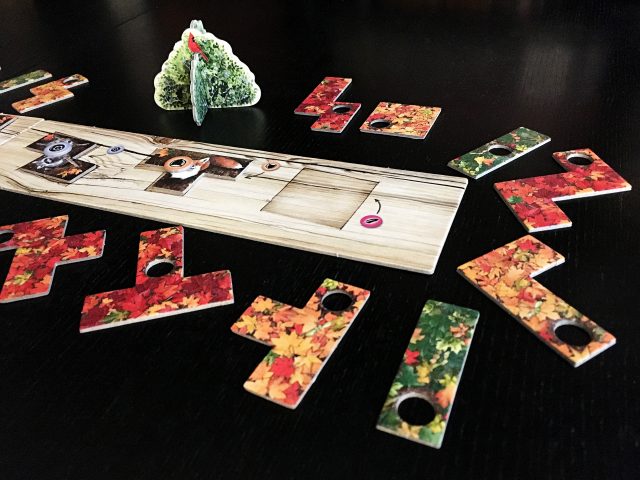Uwe Rosenberg is the kind of designer who, when he finds a mechanic he likes, spends the next few years spinning out variation after variation on it–tweaking it here, adding a new layer on there. I enjoy, at least on an intellectual level, seeing how a master craftsman like Rosenberg takes an idea and keeps at it, game after game, coming at a basic mechanic from different angles, trying out different permutations. Like Picasso with his Blue Period, his Cubism, and his fascination with African Art, Rosenberg seems to get almost obsessed with an idea, and won’t let go of it until he’s wrung every last possibility from it.
Or every last dollar. Publishing games is a risky business, with the accent on business, and Rosenberg’s method can’t help but appeal to publishers who want a Sure Thing. And the “thing” is, sales figures bear out the fact that there are, indeed, enough people out there who buy his stuff. Who, despite the “cult of the new” mentality, secretly (or not so secretly) prefer the known to the unknown.
 These games are all good, even great, don’t get me wrong. It’s just…I think of him as the boardgame equivalent of Harry Turtledove or Tom Clancy. Steady. Reliable. Quality can’t-put-it-down work. But there comes a point where I question the need for yet another version of, say, a game about trading beans. And yet, as I said, others disagree.
These games are all good, even great, don’t get me wrong. It’s just…I think of him as the boardgame equivalent of Harry Turtledove or Tom Clancy. Steady. Reliable. Quality can’t-put-it-down work. But there comes a point where I question the need for yet another version of, say, a game about trading beans. And yet, as I said, others disagree.
Which brings me to my Uwe Rosenberg retrospective from early last year, in which I mapped out Rosenberg’s major Periods–I called them Dynasties–and said the following:
“The Patchwork Dynasty (2014 – present) is the newest and therefore tiniest of the Dynasties, but if Rosenberg’s oeuvre is any indication, we’ll be seeing new heirs in the years to come.”
In retrospect, it’s 2016’s A Feast For Odin which is the crossover, the “missing link” if you will, between the Agricola worker-placement Dynasty and the Patchwork cover-a-board-with-Tetris-tiles Dynasty. And now here we are in early 2018 with the release of Indian Summer, the latest in the Patchwork line, and there is also news of a soon-to-be-released Patchwork Express, which to me is like, “Really? ‘Cos it’s pretty Express already.” But that’s our Uwe.
This time leading we’re on a hike through the woods in this game where players race to complete their individual Forest Floor boards. (So, continuing with the homespun Anne-of-Green-Gables aesthetic, then.)
But in Indian Summer, placing tiles is a two-step process, from the now-familiar ring of Tetris-shaped tiles around a common storage area, to individual Backpacks which can store up to six pieces, and then to the Forest floor.
 Completing a subsection of your Floor (called an Area) gives you all the forest Treasures in that Area: berries, nuts, mushrooms, and feathers. Berries let you replenish your Backpack, Nuts let you place single-square Squirrel tiles, Mushrooms let you leech your opponents’ tiles (yikes!), and feathers let you place two tiles for once action. All these greatly speed up the rate you can cover up your Floor. But acquiring Treasures is not so straightforward…
Completing a subsection of your Floor (called an Area) gives you all the forest Treasures in that Area: berries, nuts, mushrooms, and feathers. Berries let you replenish your Backpack, Nuts let you place single-square Squirrel tiles, Mushrooms let you leech your opponents’ tiles (yikes!), and feathers let you place two tiles for once action. All these greatly speed up the rate you can cover up your Floor. But acquiring Treasures is not so straightforward…
Because Rosenberg has added a major layer to strategy in that tiles now have holes in them, and to obtain your Treasures you have to play your tiles so that the Treasures on your Forest Floor are visible through the holes; when an Area is completed, only those Treasures can be harvested.
If you are extra-adept in placing your tiles, you’ll also be able to harvest your Treasures a second time by covering the holes on your tiles with special Animal tiles. And because Treasures can be traded for each other in fixed quantities, you have a great deal of tactical and strategic flexibility. Clearly, learning how to combo your Treasures for maximum effect is the key to success.
The Mushroom factor makes Indian Summer a lot more interactive than the other games in this series. This will either be a plus or a minus depending on your play style. And because there are many more options available, the came can bog down for players who get overwhelmed by choice. However, if you and your mates play briskly the game plays really quickly and you can get in several games in one session if that’s your inclination. It is the kind of game where, when you finish one game, you want to play again immediately because you’ve thought of new combos and possibilities.
Plus, it has a challenging solo mode where you have ten turns to cover your board. There are a few minor modifications to the rules, but otherwise it’s a great way to hone your skills and you can Analysis Paralysis as much as you want.
So perhaps surprisingly in light of how I started this article, I think Indian Summer does, actually, justify its existence in terms of having enough different about it. It does “Patchwork multiplayer” better than Cottage Garden, plus it’s got the solo thing going for it. Visually it’s stunning, if you’re the kind that likes to go out and look at the fall colours. Which, considering it’s February, is either ironic or just mean, you decide.
And now we just sit back and wait for Patchwork Express. And Patchwork: The Dice Game. And Patchwork: The Card Game. And…
Comments
No comments yet! Be the first!